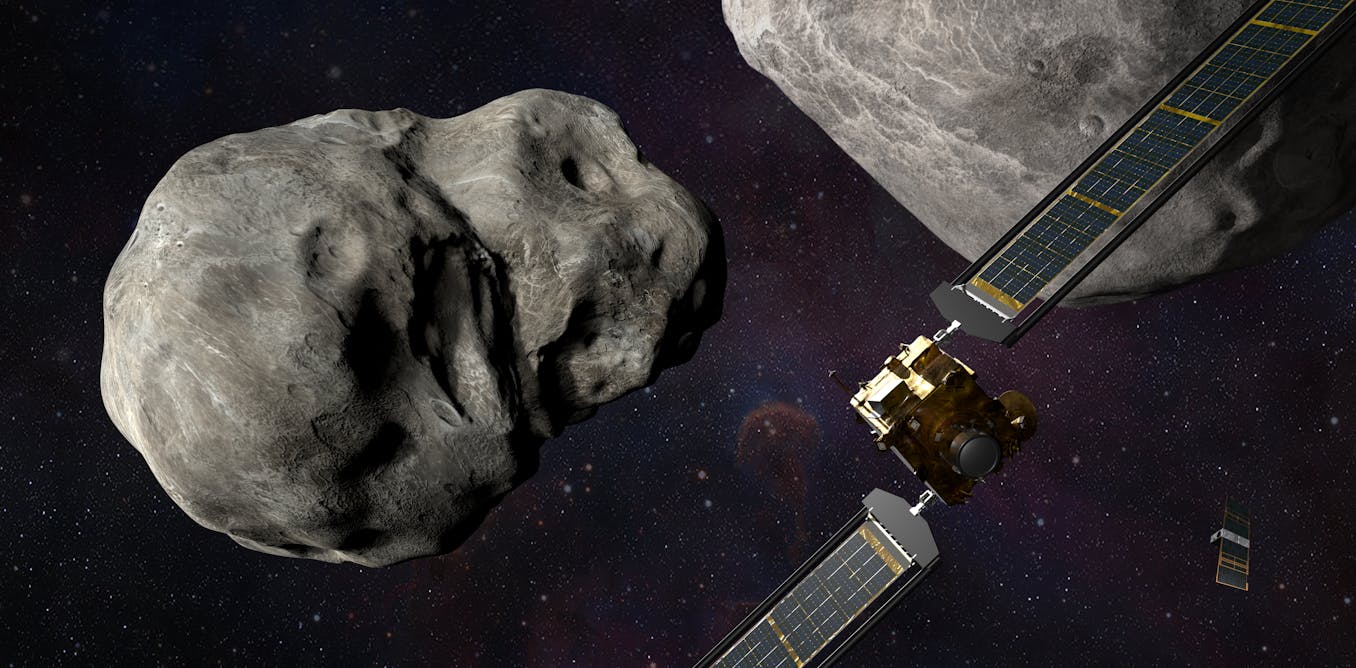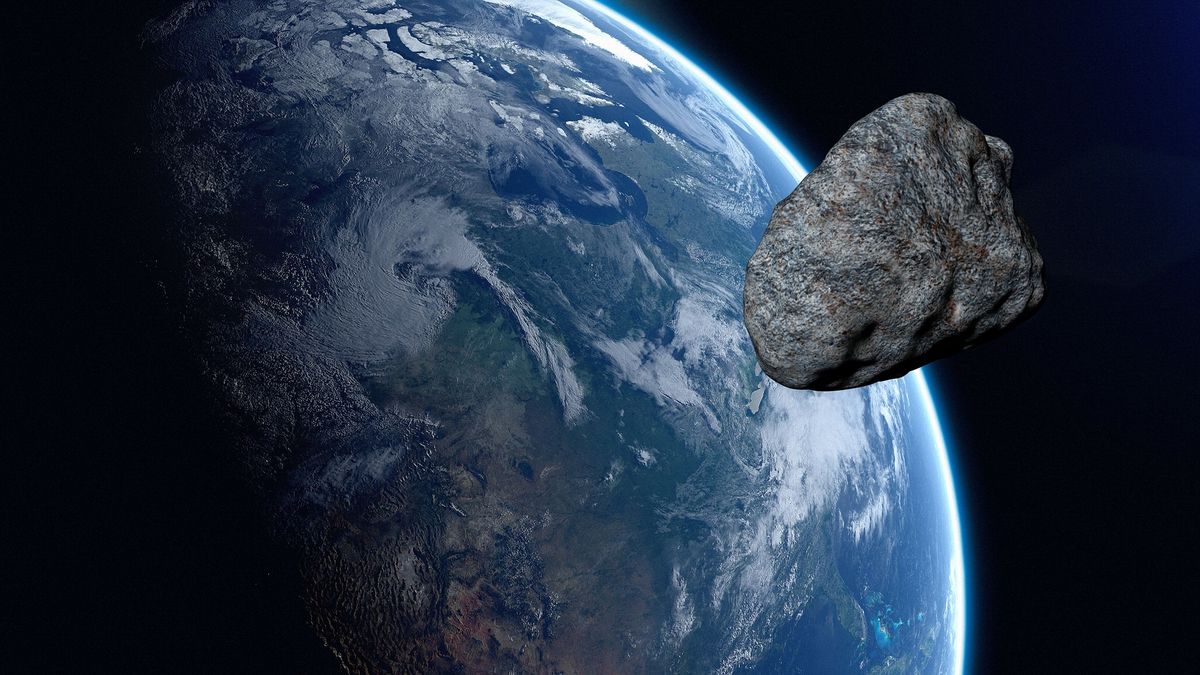Large asteroid flies close to Earth, not spotted until two days later

Large asteroid flies close to Earth, not spotted until two days later
On July 20, 2023, Earth experienced a close encounter with an asteroid that passed by, coming even closer to our planet than the moon. Astronomers detected the asteroid’s presence only two days after the event occurred, raising concerns about our ability to promptly monitor and detect potential near-Earth objects (NEOs).
The asteroid, named 2023 NB2, was estimated to be about 200 feet (60 meters) in diameter, making it relatively small compared to some other NEOs that have been observed. However, despite its size, the proximity of the asteroid to Earth posed a potential risk if it had been on a collision course.
The incident highlights the importance of enhancing our capabilities for detecting and tracking asteroids and other space objects that come close to Earth. Astronomers and space agencies around the world are continuously working to improve early warning systems to identify and assess potential threats from NEOs.
The discovery of 2023 NB2 after its close approach underscores the need for more comprehensive monitoring and coordination efforts among astronomers and space agencies. Detecting such objects in advance is crucial to develop strategies for mitigating potential impact risks, if necessary.

While this particular asteroid did not pose a threat to Earth during its recent pass, it serves as a reminder of the importance of ongoing efforts to enhance our understanding of near-Earth space and to be prepared for any future encounters with potentially hazardous objects.
As technology and observation techniques improve, it is hoped that we will be able to detect and track even smaller NEOs well in advance, giving us sufficient time to assess their trajectories and implement any necessary measures to ensure the safety of our planet. In the meantime, continued vigilance and collaboration among the global scientific community will be essential to enhance our ability to monitor and respond to potential space hazards.
The asteroid 2023 NT1, approximately 60 meters in size, was first observed on July 15, 2023, by the Atlas Observatory in South Africa. This object was travelling at an estimated speed of 86,000 km/h (about 53,000 mph) as it approached Earth.

The asteroid came within a 60,000-mile (approximately 96,560 kilometres) radius of our planet, which is about one-quarter of the distance between Earth and the moon.
Nasa, the United States space agency, reported the close approach of the asteroid and highlighted its proximity to Earth. Despite the relatively small size of 2023 NT1 compared to some other near-Earth objects (NEOs), its passage within such a close distance raised concerns about the need for improved detection and monitoring of such objects.
While the asteroid did not collide with Earth and safely passed by, this event underscores the importance of constant vigilance in monitoring space objects and the potential risks they may pose to our planet. Detecting and tracking NEOs well in advance can provide critical information for scientists and space agencies to assess any potential impact risks and plan appropriate responses, if necessary.
Astronomers and researchers around the world are continuously working to enhance our capabilities for early detection of NEOs, and international collaborations and coordination efforts are vital in this regard. The incident with 2023 NT1 serves as a reminder of the ongoing efforts needed to improve our understanding of the cosmos and protect our planet from potential space hazards.
The asteroid 2023 NT1 was observed for the first time on July 15, but it had already made its closest approach to Earth two days earlier on July 13. This means that by the time astronomers detected the asteroid, it had already passed by Earth and was moving away from our planet. The delayed discovery highlights the challenge of detecting and tracking near-Earth objects (NEOs) that can approach our planet from various directions and at different speeds.
This incident underscores the need to improve our asteroid detection and monitoring capabilities. Detecting NEOs early allows scientists and space agencies to assess potential impact risks and plan appropriate responses, if necessary, to protect Earth from potential hazards posed by space objects.
To enhance our preparedness and understanding of the cosmos, ongoing international collaborations and investments in astronomy and space observation technologies are crucial. By working together, we can increase our chances of detecting and monitoring potentially hazardous objects well in advance, thus ensuring the safety and well-being of our planet.
The difficulty in detecting asteroid 2023 NT1 until it was too late highlights the challenge of observing asteroids that approach Earth from the direction of the sun. The sun’s bright glare can make it extremely difficult for telescopes to spot and track objects in its vicinity, including near-Earth asteroids. As a result, some asteroids may only become visible to astronomers when they have already passed their closest point to Earth.
While asteroid 2023 NT1 did not pose a threat to Earth, this event serves as a crucial reminder of the potential danger posed by asteroids and the importance of improving our asteroid detection and monitoring capabilities. Identifying and tracking near-Earth objects is vital for assessing potential impact risks and taking necessary precautions to safeguard our planet from any future threats.
To address the sun’s blind spot in asteroid detection, astronomers and space agencies are continually developing new observation techniques and technologies. Advanced telescopes and sky surveys, both on the ground and in space, are being used to enhance our ability to detect and track asteroids from all angles, including those coming from the direction of the sun.
International collaborations and investments in asteroid detection and monitoring are essential to ensure that we are well-prepared to identify and assess potential asteroid hazards and take appropriate actions to protect our planet and its inhabitants.The Chelyabinsk incident in 2013 serves as a stark reminder of the potential impact hazards posed by small asteroids that can go undetected until they enter Earth’s atmosphere. The explosion of the approximately 59-foot-long (18 m) asteroid over Russia released a powerful shock wave that caused widespread damage and injuries to nearly 1,500 people.
This event highlights the importance of improving our asteroid detection capabilities, especially for smaller objects that may not be immediately visible due to the sun’s glare or other observational challenges. The European Space Agency’s estimation that there could be a million asteroids in the size range of 30 to 100 meters near Earth, with the vast majority still undiscovered, underscores the need for more comprehensive and advanced asteroid survey programs.
To address this issue, space agencies and astronomers around the world are actively working on expanding asteroid detection efforts. Ground-based telescopes, space-based observatories, and sky surveys are being deployed to scan the skies more comprehensively, reducing the chances of potential asteroid surprises. Additionally, international collaborations and data-sharing initiatives play a critical role in pooling resources and expertise to increase our ability to detect and track near-Earth objects.
The goal is not only to identify and monitor known asteroids but also to discover new ones early on, giving us ample time to assess potential impact risks and develop mitigation strategies if needed. By investing in these efforts and raising awareness about asteroid hazards, we can enhance our preparedness and response capabilities to safeguard against potential future asteroid impacts.
The NEOMIR (Near-Earth Object Monitor with an IR Telescope) mission is a promising initiative by the European Space Agency (ESA) aimed at addressing the challenge posed by asteroids that are difficult to detect due to the solar blind spot. As scientists already monitor more than 31,000 known near-Earth asteroids, the focus of NEOMIR is on detecting larger asteroids that could still pose a significant threat but are currently hidden in the glare of the sun.
Scheduled to launch around 2030, the NEOMIR satellite will be strategically positioned between Earth and the sun, allowing it to observe regions of space that are typically obscured by the sun’s brightness from Earth-based telescopes. The satellite will utilize an infrared telescope, which is capable of detecting the heat emitted by asteroids even when they are not visible through optical telescopes.
By leveraging infrared technology, NEOMIR aims to identify and track larger asteroids that may otherwise go undetected until they get close to Earth.

The mission’s objective is to provide advanced warning and accurate trajectory data for these potential impact hazards, allowing scientists and space agencies to better assess the risks and take appropriate mitigation measures if necessary.
As NEOMIR complements existing asteroid detection efforts, it will significantly enhance our ability to monitor the skies for potentially hazardous near-Earth objects. This proactive approach is vital for planetary defence and ensures that we can be better prepared to respond to any potential asteroid threats that might arise in the future.




